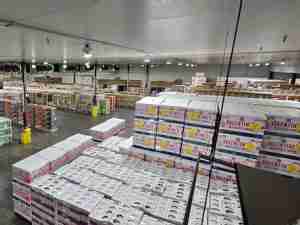In this day and age, the world seems much smaller than it was even 50 years ago. Information travels incredibly fast but that’s not all. Today, you can ship almost anything across the world and it can arrive to your desired destination in a day or two. However, there are some rules we need to follow when we’re moving things around the globe. Some of these transporting rules aren’t very crucial. They’re meant to protect the shipment from someone else claiming it. On the other hand, some of the shipping rules are crucial for maintaining your personal safety and the safety of the environment. With the transportation of dangerous goods, make sure you abide by these rules to avoid damage and huge legal fees.

What are dangerous goods?
Dangerous goods are substances which can cause serious damage to you, your property and the environment. In some cases, these hazardous materials can cause damage on a much bigger scale. The first step in safely transporting dangerous materials is to identify them. Once you do this, everything else is a bit clearer. However, pay attention to follow the correct procedures when identifying these substances. Do not smell or taste them, since you can get poisoned or hurt.
All dangerous goods are labeled.
We classify all of these materials into nine classes:
- Explosives - these are considered dangerous goods due to the obvious damage they can cause to both people and structures.
- Gases - considered hazardous because they can cause asphyxiation and they’re usually flammable. Even liquified and dissolved gases fall into this category.
- Flammable liquids - highly combustible and volatile liquids.
- Flammable solids - compounds in solid state which can burst into flame through nothing more than friction.
- Oxidizing substances - even though these aren’t necessarily flammable themselves, they can be used to fuel other combustible compounds.
- Toxic and infectious substances - anything that can cause serious damage to humans if you inhale, swallow or touch it. In addition to this, bacteria, pathogens and viruses fall into this group too.
- Radioactive substances - items and compounds which go through radioactive decay which can cause harmful radiation to humans and the environment.
- Corrosive substances - compounds and solutions which destroy organic tissue when they come into contact with it.
- Miscellaneous - goods which can be hazardous to humans and the environment, but present the type of danger which doesn’t fall into any other class. As far as transportation of dangerous goods is concerned, these are the rarest.
Know how to handle them
The next step in the transportation of dangerous goods is to learn how to handle specific goods. Some people consider moving their home across the country a difficult task. However, the consequences of damaging a canister of gas are much larger than breaking your grandfather’s clock. Thus, this type of transport is even more difficult than moving heavy cargo across the country! This is why you’ll need to handle these materials with extreme care!
Train your people
You should always leave the handling of these substances to professionals. Some moving companies specialize in this, but even your average mover will know who to turn to for help. The best solution would be to hire international movers like Easy Move KW to help you.

However, if you’re a company dealing with transporting hazardous materials, you’ll need to make sure your staff is trained to handle them! Have your people take a seminar or a course about handling and moving these substances. Make sure all of the people handling the goods know the proper procedures in case something unforeseen happens. In addition to this, you’ll need to have adequate equipment. HazMat suits, flame retardants and proper training can save lives in the transportation of dangerous goods. The safety of the people moving these substances should always come first.
Proper equipment can save lives when handling hazardous materials.
Know the procedures
When moving hazardous materials, it’s imperative that their containers arrive to the location undamaged. This is why there are numerous procedures you’ll need to get familiar with before you attempt any transportation of dangerous goods. These procedures might require you to upgrade your facilities in order to accommodate hazardous materials, as Fos Distriport did in 2017.
Know how to pack them
First off, there’s packing! Apart from proper handling, the package is the only thing standing between a dangerous substance and the world. So, make sure the package survives the transport in one piece. To achieve this, you’ll need to know the right packing materials for each of the nine classes of hazardous goods. These materials were prescribed by the UN and should be used in the transportation of dangerous goods.
Pack your hazardous materials as prescribed by the UN.
Label
Once you’ve hired someone to pack your goods for transportation, you’ll need to put all the information about the package on something called the Safety Data Sheet (SDS). The information in the SDS must always be in English, if you’re importing or exporting goods out of the US. It should contain:
Package ID
- The name of the substance being transported
- The class (one of the 9 possible classes)
- The packaging materials used
- The quantity of the substance
- Packaging instructions
- The manufacturer’s, importer’s and distributor’s information
Proper labeling will ensure nothing bad happens.
This information is crucial as it will enable anyone who handles your package to know they should be careful. And since your package will go through many different customs and other processing stations, it is instrumental that it gets treated with care.
Determine the best mode of transport
This is the last but definitely not the least of the tasks you should handle when moving hazardous materials. Depending on the class of your substance and the destination, you’ll need to find the best means of transport. Transportation of hazardous materials by a plane is perilous and thus requires proper training and safety measures. It’s risky to be in the air with something that can blow up or catch on fire.
The more popular methods for transportation of dangerous goods are by railroad (for the transports inside the States) and shipping your goods via sea to send them to other countries. If you’re planning on sending or receiving hazardous materials, make sure you call the professionals to help you handle it. Even a small mistake can have terrible consequences with these substances! So, be very careful!







_-_28de80_-_d88095865f9f1cbb4ecdd37edf61c63efd603428_lqip.png)

